Flexible Capacitive Pressure Sensor Based on Microstructured Composite Dielectric Layer for Broad Linear Range Pressure Sensing Applications
Abstract
:1. Introduction
2. Materials and Methods
2.1. Preparation of the CB/CNTs/PDMS Composite Prepolymer
2.2. Fabrication of the Flexible Capacitive Pressure Sensor
2.3. Characterization of the Dielectric Composite and the Pressure Sensor
3. Results and Discussion
3.1. Structure of the Flexible Capacitive Pressure Sensor
3.2. Dielectric Properties of the CB/CNTs/PDMS Composite
3.3. Sensing Mechanism of the Flexible Capacitive Pressure Sensor
3.4. Performance of the Flexible Capacitive Pressure Sensor
3.5. Practical Application of the Flexible Capacitive Preeesure Sensor
4. Conclusions
Author Contributions
Funding
Conflicts of Interest
References
- Shi, Y.; Lu, X.; Wang, W.; Meng, X.; Zhao, J.; Wang, P.; Bai, G. Multilayer Flexible Pressure Sensor with High Sensitivity Over Wide Linearity Detection Range (August 2021). IEEE Trans. Instrum. Meas. 2021, 70, 9511809. [Google Scholar] [CrossRef]
- Zhu, L.; Wang, Y.; Mei, D.; Jiang, C. Development of Fully Flexible Tactile Pressure Sensor with Bilayer Interlaced Bumps for Robotic Grasping Applications. Micromachines 2020, 11, 770. [Google Scholar] [CrossRef] [PubMed]
- Lü, X.; Qi, L.; Hu, H.; Li, X.; Bai, G.; Chen, J.; Bao, W. Ultra-Sensitive Flexible Tactile Sensor Based on Graphene Film. Micromachines 2019, 10, 730. [Google Scholar] [CrossRef] [PubMed] [Green Version]
- Navaraj, W.; Dahiya, R. Fingerprint-Enhanced Capacitive-Piezoelectric Flexible Sensing Skin to Discriminate Static and Dynamic Tactile Stimuli. Adv. Intell. Syst. 2019, 1, 1900051. [Google Scholar] [CrossRef]
- Mu, C.; Li, J.; Song, Y.; Huang, W.; Ran, A.; Deng, K.; Huang, J.; Xie, W.; Sun, R.; Zhang, H. Enhanced Piezocapacitive Effect in CaCu3Ti4O12–Polydimethylsiloxane Composited Sponge for Ultrasensitive Flexible Capacitive Sensor. ACS Appl. Nano Mater. 2018, 1, 274–283. [Google Scholar] [CrossRef]
- Luo, Z.; Duan, J.; Xu, H.; Wang, Y.; Liu, J.; Yao, X.; Zhang, B. Flexible Capacitive Pressure Sensor Based on an Embedded Rib Fabric with a Bionic Sloping Petal Structure. IEEE Sens. J. 2021, 21, 20119–20128. [Google Scholar] [CrossRef]
- Guo, Z.; Mo, L.; Ding, Y.; Zhang, Q.; Meng, X.; Wu, Z.; Chen, Y.; Cao, M.; Wang, W.; Li, L. Printed and Flexible Capacitive Pressure Sensor with Carbon Nanotubes based Composite Dielectric Layer. Micromachines 2019, 10, 715. [Google Scholar] [CrossRef] [Green Version]
- Park, Y.; Shin, Y.-E.; Park, J.; Lee, Y.; Kim, M.; Kim, Y.-R.; Na, S.; Ghosh, S.K.; Ko, H. Ferroelectric Multilayer Nanocomposites with Polarization and Stress Concentration Structures for Enhanced Triboelectric Performances. ACS Nano 2020, 14, 7101–7110. [Google Scholar] [CrossRef]
- Kumaresan, Y.; Ma, S.; Ozioko, O.; Dahiya, R. Soft Capacitive Pressure Sensor with Enhanced Sensitivity assisted by ZnO NW Interlayers and Airgap. IEEE Sens. J. 2022; in press. [Google Scholar] [CrossRef]
- Chang, H.; Kim, S.; Kang, T.-H.; Lee, S.-W.; Yang, G.-T.; Lee, K.-Y.; Yi, H. Wearable Piezoresistive Sensors with Ultrawide Pressure Range and Circuit Compatibility Based on Conductive-Island-Bridging Nanonetworks. ACS Appl. Mater. Interfaces 2019, 11, 32291–32300. [Google Scholar] [CrossRef]
- Niu, H.; Gao, S.; Yue, W.; Li, Y.; Zhou, W.; Liu, H. Highly Morphology-Controllable and Highly Sensitive Capacitive Tactile Sensor Based on Epidermis-Dermis-Inspired Interlocked Asymmetric-Nanocone Arrays for Detection of Tiny Pressure. Small 2020, 16, e1904774. [Google Scholar] [CrossRef]
- Guo, Y.; Gao, S.; Yue, W.; Zhang, C.; Li, Y. Anodized Aluminum Oxide-Assisted Low-Cost Flexible Capacitive Pressure Sensors Based on Double-Sided Nanopillars by a Facile Fabrication Method. ACS Appl. Mater. Interfaces 2019, 11, 48594–48603. [Google Scholar] [CrossRef] [PubMed]
- Wang, X.; Xia, Z.; Zhao, C.; Huang, P.; Zhao, S.; Gao, M.; Nie, J. Microstructured flexible capacitive sensor with high sensitivity based on carbon fiber-filled conductive silicon rubber. Sens. Actuators A Phys. 2020, 312, 112147. [Google Scholar] [CrossRef]
- Xiong, Y.; Shen, Y.; Tian, L.; Hu, Y.; Zhu, P.; Sun, R.; Wong, C.-P. A flexible, ultra-highly sensitive and stable capacitive pressure sensor with convex microarrays for motion and health monitoring. Nano Energy 2020, 70, 104436. [Google Scholar] [CrossRef]
- Shi, R.; Lou, Z.; Chen, S.; Shen, G. Flexible and transparent capacitive pressure sensor with patterned microstructured composite rubber dielectric for wearable touch keyboard application. Sci. China Mater. 2018, 61, 1587–1595. [Google Scholar] [CrossRef] [Green Version]
- Luo, Y.; Shao, J.; Chen, S.; Chen, X.; Tian, H.; Li, X.; Wang, L.; Wang, D.; Lu, B. Flexible Capacitive Pressure Sensor Enhanced by Tilted Micropillar Arrays. ACS Appl. Mater. Interfaces 2019, 11, 17796–17803. [Google Scholar] [CrossRef]
- Tay, R.Y.; Li, H.; Lin, J.; Wang, H.; Lim, J.S.K.; Chen, S.; Leong, W.L.; Tsang, S.H.; Teo, E.H.T. Lightweight, Superelastic Boron Nitride/Polydimethylsiloxane Foam as Air Dielectric Substitute for Multifunctional Capacitive Sensor Applications. Adv. Funct. Mater. 2020, 30, 1909604. [Google Scholar] [CrossRef]
- Qiu, J.; Guo, X.; Chu, R.; Wang, S.; Zeng, W.; Qu, L.; Zhao, Y.; Yan, F.; Xing, G. Rapid-Response, Low Detection Limit, and High-Sensitivity Capacitive Flexible Tactile Sensor Based on Three-Dimensional Porous Dielectric Layer for Wearable Electronic Skin. ACS Appl. Mater. Interfaces 2019, 11, 40716–40725. [Google Scholar] [CrossRef]
- Choi, J.; Kwon, D.; Kim, K.; Park, J.; Del Orbe, D.; Gu, J.; Ahn, J.; Cho, I.; Jeong, Y.; Oh, Y.S.; et al. Synergetic Effect of Porous Elastomer and Percolation of Carbon Nanotube Filler toward High Performance Capacitive Pressure Sensors. ACS Appl. Mater. Interfaces 2020, 12, 1698–1706. [Google Scholar] [CrossRef]
- Guo, X.; Huang, Y.; Cai, X.; Liu, C.; Liu, P. Capacitive wearable tactile sensor based on smart textile substrate with carbon black /silicone rubber composite dielectric. Meas. Sci. Technol. 2016, 27, 045105. [Google Scholar] [CrossRef]
- Li, T.; Luo, H.; Qin, L.; Wang, X.; Xiong, Z.; Ding, H.; Gu, Y.; Liu, Z.; Zhang, T. Flexible Capacitive Tactile Sensor Based on Micropatterned Dielectric Layer. Small 2016, 12, 5042–5048. [Google Scholar] [CrossRef]
- Zhou, Q.; Ji, B.; Wei, Y.; Hu, B.; Gao, Y.; Xu, Q.; Zhou, J.; Zhou, B. A bio-inspired cilia array as the dielectric layer for flexible capacitive pressure sensors with high sensitivity and a broad detection range. J. Mater. Chem. A 2019, 7, 27334–27346. [Google Scholar] [CrossRef]
- Bai, N.; Wang, L.; Wang, Q.; Deng, J.; Wang, Y.; Lu, P.; Huang, J.; Li, G.; Zhang, Y.; Yang, J.; et al. Graded intrafillable architecture-based iontronic pressure sensor with ultra-broad-range high sensitivity. Nat. Commun. 2020, 11, 20. [Google Scholar] [CrossRef] [PubMed] [Green Version]
- Choi, H.B.; Oh, J.; Kim, Y.; Pyatykh, M.; Yang, J.C.; Ryu, S.; Park, S. Transparent Pressure Sensor with High Linearity over a Wide Pressure Range for 3D Touch Screen Applications. ACS Appl. Mater. Interfaces 2020, 12, 16691–16699. [Google Scholar] [CrossRef] [PubMed]
- Atalay, O.; Atalay, A.; Gafford, J.; Walsh, C. A Highly Sensitive Capacitive-Based Soft Pressure Sensor Based on a Conductive Fabric and a Microporous Dielectric Layer. Adv. Mater. Technol. 2018, 3, 1700237. [Google Scholar] [CrossRef]
- Liu, X.; Li, C.; Wang, Z.; Lia, Y.; Huang, J.; Yu, H. Wide-Range Flexible Capacitive Pressure Sensors Based on Origami Structure. IEEE Sens. J. 2021, 21, 9798–9807. [Google Scholar] [CrossRef]
- Ji, B.; Zhou, Q.; Hu, B.; Zhong, J.; Zhou, J.; Zhou, B. Bio-Inspired Hybrid Dielectric for Capacitive and Triboelectric Tactile Sensors with High Sensitivity and Ultrawide Linearity Range. Adv. Mater. 2021, 33, 2100859. [Google Scholar] [CrossRef] [PubMed]
- Fu, X.; Zhang, J.; Xiao, J.; Kang, Y.; Yu, L.; Jiang, C.; Pan, Y.; Dong, H.; Gao, S.; Wang, Y. A high-resolution, ultrabroad-range and sensitive capacitive tactile sensor based on a CNT/PDMS composite for robotic hands. Nanoscale 2021, 13, 18780–18788. [Google Scholar] [CrossRef] [PubMed]
- Ji, B.; Zhou, Q.; Lei, M.; Ding, S.; Song, Q.; Gao, Y.; Li, S.; Xu, Y.; Zhou, Y.; Zhou, B. Gradient Architecture-Enabled Capacitive Tactile Sensor with High Sensitivity and Ultrabroad Linearity Range. Small 2021, 17, 2103312. [Google Scholar] [CrossRef]
- Chen, Y.; Liu, Y.; Yang, J.; Zhang, B.; Hu, Z.; Wang, Q.; Wu, W.; Shang, Y.; Xia, Y.; Duan, Y.; et al. Fabrication of high dielectric permittivity polymer composites by architecting aligned micro-enhanced-zones of ultralow content graphene using electric fields. Mater. Today Commun. 2019, 21, 100649. [Google Scholar] [CrossRef]
- Wang, J.; Jiu, J.; Nogi, M.; Sugahara, T.; Nagao, S.; Koga, H.; He, P.; Suganuma, K. A highly sensitive and flexible pressure sensor with electrodes and elastomeric interlayer containing silver nanowires. Nanoscale 2015, 7, 2926–2932. [Google Scholar] [CrossRef]
- Johnston, I.; McCluskey, D.; Tan, C.K.L.; Tracey, M. Mechanical characterization of bulk Sylgard 184 for microfluidics and microengineering. J. Micromech. Microeng. 2014, 24, 35017. [Google Scholar] [CrossRef]
- Huang, J.; Wang, F.; Xu, X.; Hu, R.; Wang, Z.; Wang, H. Adjusting Sensitivity and Linearity of the Wearable Pressure Sensors by an Arbitrary Micro-Protuberance Structure of Polyvinylidene Fluoride/Reduced Graphene Oxide Dielectric Films. Adv. Eng. Mater. 2021, 23, 2100326. [Google Scholar] [CrossRef]
- He, X.; Liu, Z.; Shen, G.; He, X.; Liang, J.; Zhong, Y.; Liang, T.; He, J.; Xin, Y.; Zhang, C.; et al. Microstructured capacitive sensor with broad detection range and long-term stability for human activity detection. NPJ Flex. Electron. 2021, 5, 17. [Google Scholar] [CrossRef]
- Li, W.; Jin, X.; Zheng, Y.; Chang, X.; Wang, W.; Lin, T.; Zheng, F.; Onyilagha, O.; Zhu, Z. A porous and air gap elastomeric dielectric layer for wearable capacitive pressure sensor with high sensitivity and a wide detection range. J. Mater. Chem. C 2020, 8, 11468–11476. [Google Scholar] [CrossRef]

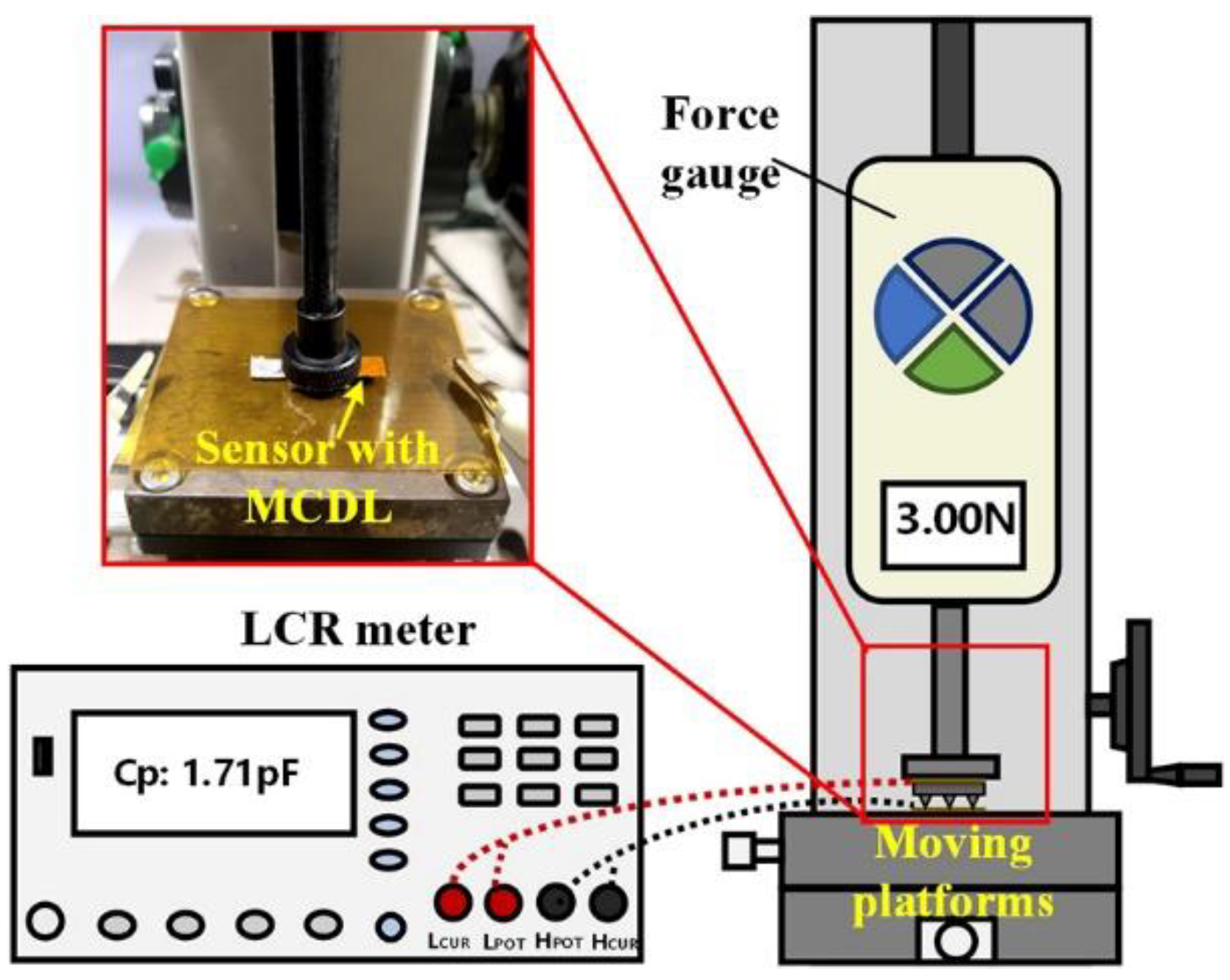
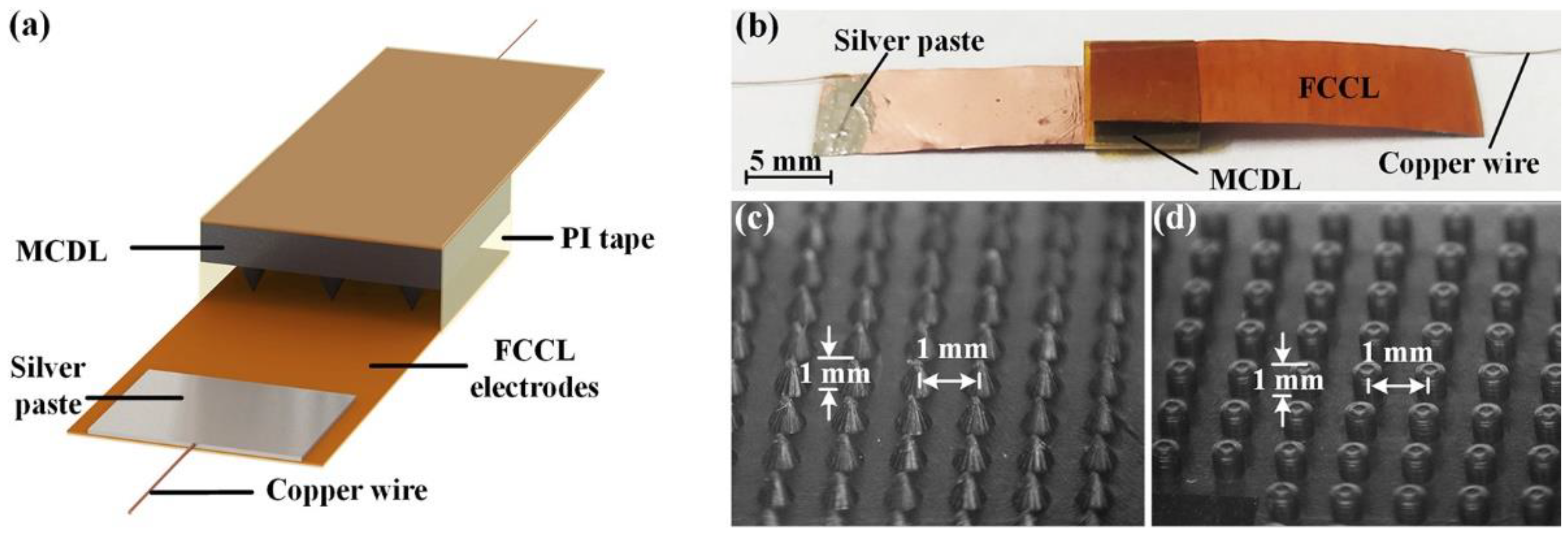

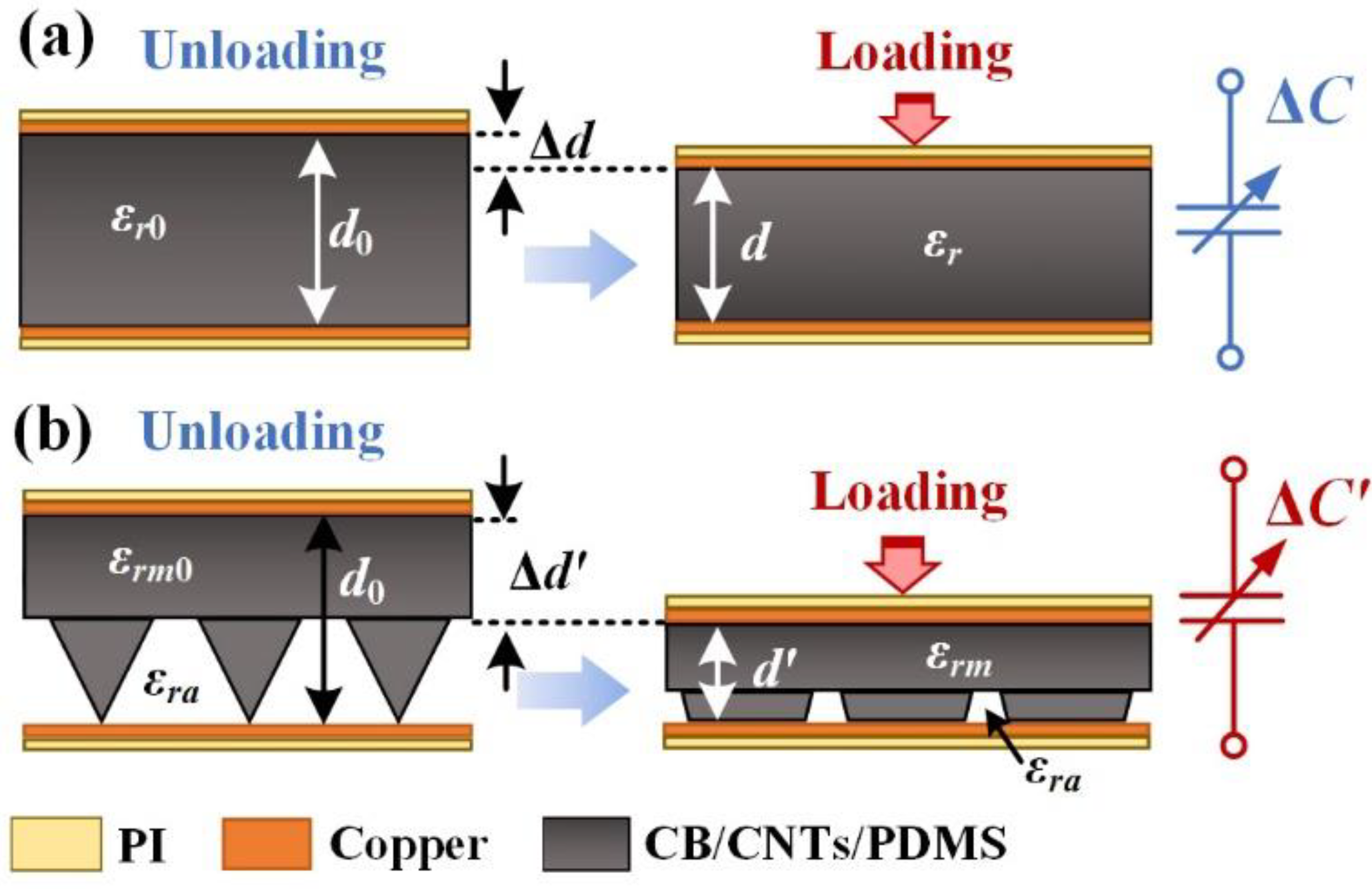
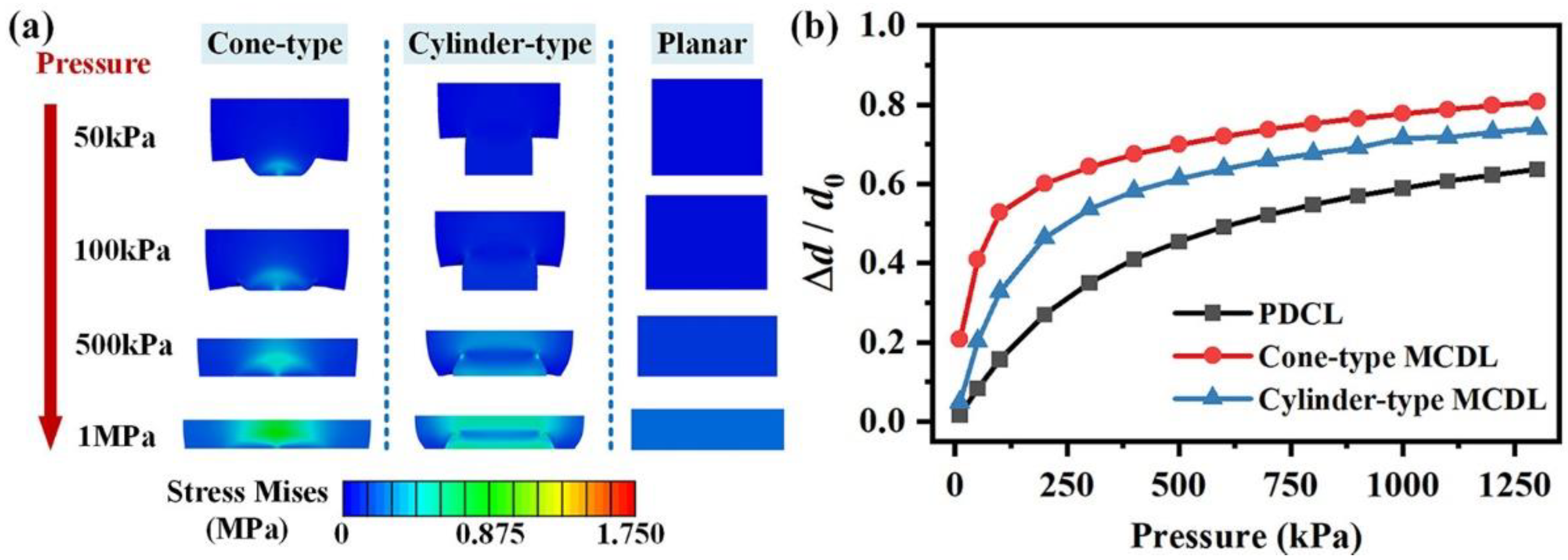
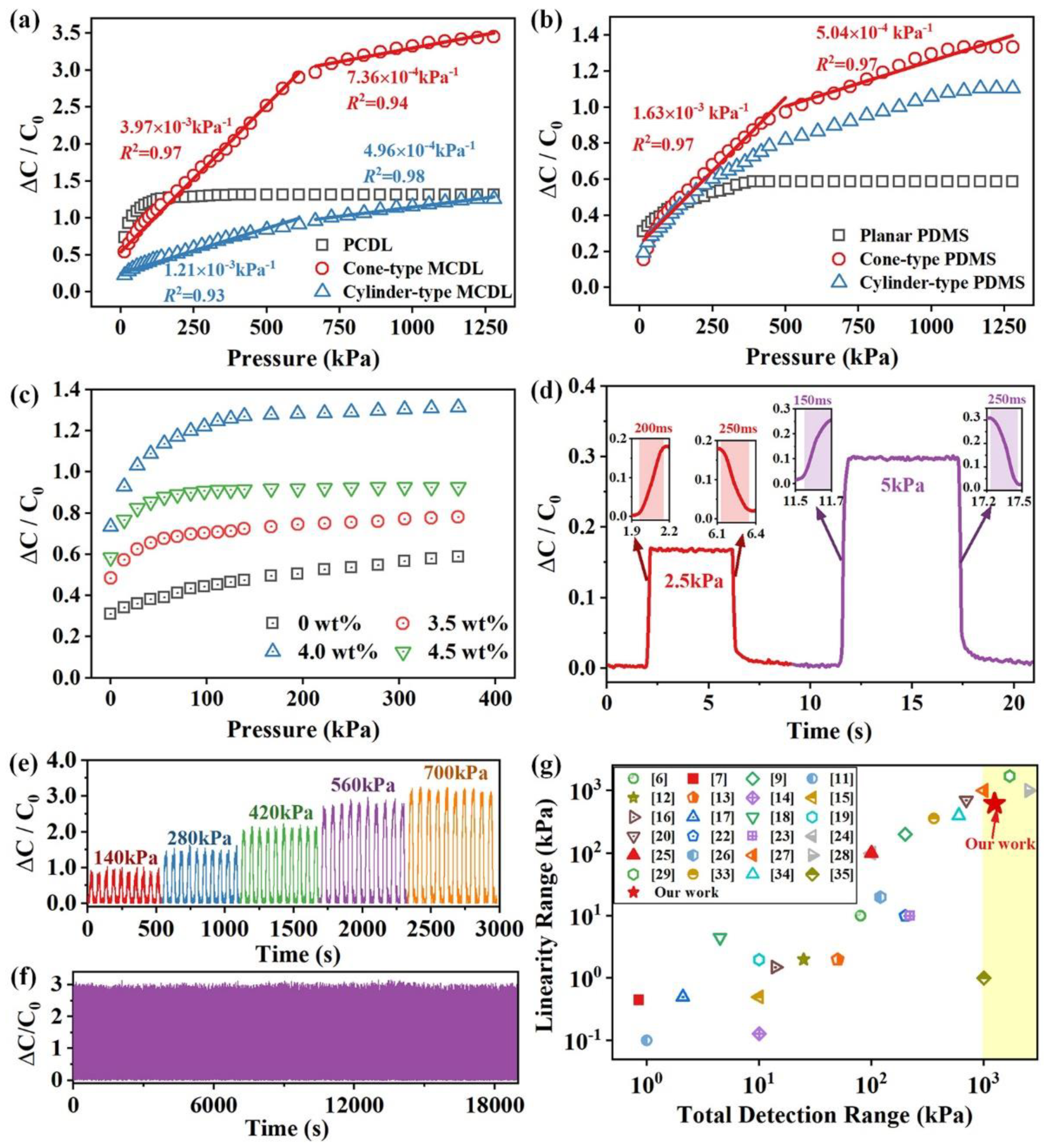

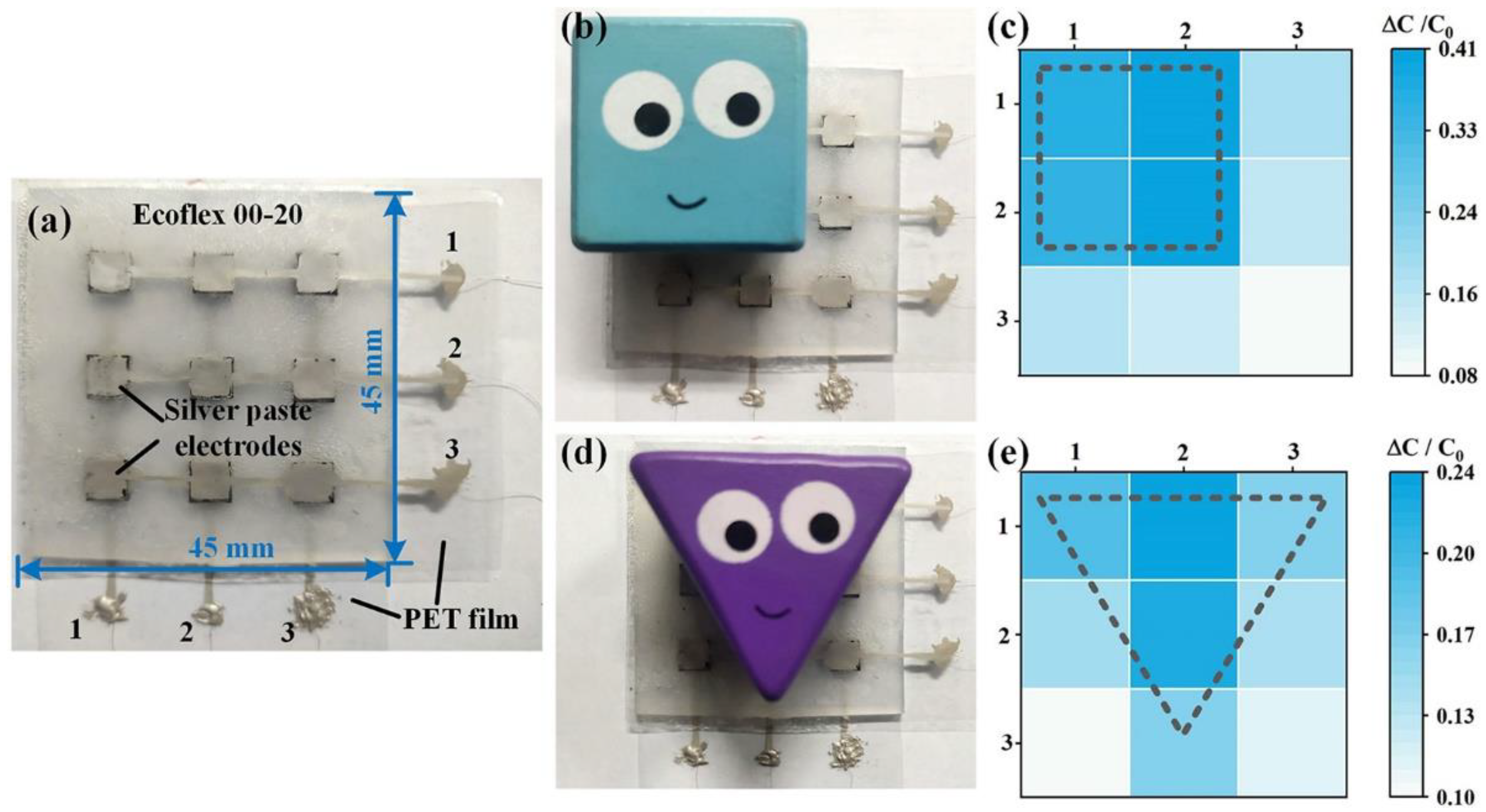
| Ref. | Dielectric Materials | Sensitivity (kPa−1) | Pressure Range (kPa) | Linearity Range (kPa) |
|---|---|---|---|---|
| [7] | CNTs/PDMS | 2.9 | 0.85 | 0.45 |
| [11] | PVDF | 6.583 | 1 | 0.1 |
| [17] | BNF/PDMS | 0.854 | 2.1 | 0.5 |
| [18] | GNPs/MWCNTs/SR/PS | 0.062 | 4.5 | 4.5 |
| [14] | PVDF | 30.2 | 10 | 0.13 |
| [15] | AgNW/PDMS | 0.831 | 10 | 0.5 |
| [19] | CNTs/Ecoflex | 6.42 | 10 | 2 |
| [16] | PDMS | 0.42 | 14 | 1.5 |
| [12] | PVDF | 0.35 | 25 | 2 |
| [13] | CPDMS/PDMS | 0.82 | 50 | 2 |
| [6] | PDMS | 0.06 | 80 | 10 |
| [24] | PEDOT:PSS/PDMS | 0.034 | 100 | 100 |
| [25] | Conductive fabric/Ecoflex | 0.0121 | 100 | 100 |
| [26] | BaTiO3/CNTs/PDMS | 0.1 | 120 | 20 |
| [22] | CIP/PDMS | 0.28 | 200 | 10 |
| [9] | Air gap/ZnO NWs/PDMS | 0.05645 | 200 | 200 |
| [23] | PVA/H3PO4 | 3302.9 | 220 | 10 |
| [33] | rGO/PVDF | 0.02 | 360 | 360 |
| [34] | PDMS | 0.00001 | 600 | 400 |
| [20] | CB/SR | 0.00025 | 700 | 700 |
| [35] | PDMS | 1.15 | 1000 | 1 |
| [27] | CIP/NdFeB/PDMS + CNT/PDMS | 0.183 | 1000 | 1000 |
| [29] | CNT/PDMS | 0.065 | 1700 | 1700 |
| [28] | CNTs/PDMS | 0.0161 | 2550 | 1000 |
| This Work | CB/CNT/PDMS | 0.00397 | 1300 | 600 |
Publisher’s Note: MDPI stays neutral with regard to jurisdictional claims in published maps and institutional affiliations. |
© 2022 by the authors. Licensee MDPI, Basel, Switzerland. This article is an open access article distributed under the terms and conditions of the Creative Commons Attribution (CC BY) license (https://creativecommons.org/licenses/by/4.0/).
Share and Cite
Shi, Y.; Lü, X.; Zhao, J.; Wang, W.; Meng, X.; Wang, P.; Li, F. Flexible Capacitive Pressure Sensor Based on Microstructured Composite Dielectric Layer for Broad Linear Range Pressure Sensing Applications. Micromachines 2022, 13, 223. https://doi.org/10.3390/mi13020223
Shi Y, Lü X, Zhao J, Wang W, Meng X, Wang P, Li F. Flexible Capacitive Pressure Sensor Based on Microstructured Composite Dielectric Layer for Broad Linear Range Pressure Sensing Applications. Micromachines. 2022; 13(2):223. https://doi.org/10.3390/mi13020223
Chicago/Turabian StyleShi, Yaoguang, Xiaozhou Lü, Jihao Zhao, Wenran Wang, Xiangyu Meng, Pengfei Wang, and Fan Li. 2022. "Flexible Capacitive Pressure Sensor Based on Microstructured Composite Dielectric Layer for Broad Linear Range Pressure Sensing Applications" Micromachines 13, no. 2: 223. https://doi.org/10.3390/mi13020223
APA StyleShi, Y., Lü, X., Zhao, J., Wang, W., Meng, X., Wang, P., & Li, F. (2022). Flexible Capacitive Pressure Sensor Based on Microstructured Composite Dielectric Layer for Broad Linear Range Pressure Sensing Applications. Micromachines, 13(2), 223. https://doi.org/10.3390/mi13020223







